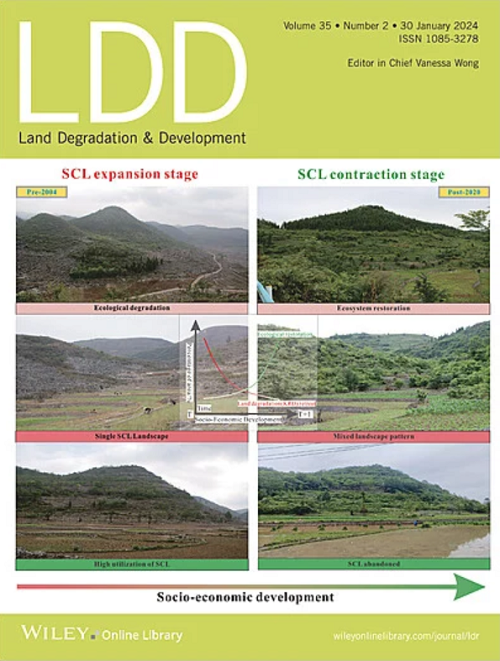有机氮综合施用对玉米-贝斯贝玉米种植顺序土壤健康、饲料能量组分和饲料产量的影响
IF 3.6
2区 农林科学
Q2 ENVIRONMENTAL SCIENCES
引用次数: 0
摘要
机械化程度的提高、化肥投入的增加和有机肥分解缓慢对有机农业的农业生产力和土壤健康构成了挑战。我们假设农家肥(FYM)、促进植物生长的根瘤菌(PGPR)和panchagavya综合施氮可以改善土壤健康、饲料能和作物产量。田间试验采用玉米(M)和白玉米(B)种植序列,采用随机完全区组设计(RCBD), 3个重复,7个处理。结果表明:T7处理(100%推荐施氮量(RDN)通过FYM + PGPR+ 3% panchagavya叶面喷雾(M) - PGPR+ 3% panchagavya叶面喷雾(B))显著提高了土壤有机碳(5.0% ~ 13.3%)、土壤有机质含量(4.85% ~ 15.7%)、速效养分(19.1% ~ 32.6%)、微生物数量(69.0% ~ 207.1%);第一年(2018-2019)至第三年(2020-2021),土壤酶活性(87.7%-163.8%)高于施用推荐剂量肥料(RDFs)的对照处理(T1)。此外,与对照(T1)相比,T7处理在种植第一年(2018-2019年)至第三年(2020-2021年)期间,玉米和玉米的饲料能分数、总可消化粗蛋白质和绿饲料产量均发生了显著变化。综上所述,T7: 100% RDN通过FYM + PGPR + 3% panchagavya叶面喷雾(M) - PGPR + 3% panchagavya叶面喷雾(B),可推荐采用有机条件下高产能有机饲料,改善土壤健康状况。本文章由计算机程序翻译,如有差异,请以英文原文为准。
Enhancing Soil Health, Fodder Energy Fractions, and Fodder Yield in Maize–Berseem Cropping Sequence Through Integrated Organic Nitrogen Fertilization
Intensified mechanization, elevated chemical inputs, and sluggish organic manure decomposition pose challenges to agricultural productivity and soil health under organic farming. We hypothesize that integrated nitrogen fertilization using farmyard manure (FYM), plant growth-promoting rhizobacteria (PGPR), and panchagavya will enhance soil health, fodder energy, and crop yield. The field experiment consisted of maize (M) and berseem (B) cropping sequences, which were laid down in a randomized complete block design (RCBD) with three replications and seven treatments. The findings showed that treatment T7 (100% recommended dose of nitrogen (RDN) through FYM + PGPR+ 3% foliar spray of panchagavya (M) – PGPR+ 3% foliar spray of panchagavya (B)) significantly improves the soil organic carbon (5.0%–13.3%), soil organic matter content (4.85%–15.7%), available nutrients (19.1%–32.6%), microbial populations (69.0%–207.1%), and soil enzymatic activities (87.7%–163.8%) from the first year (2018–2019) to the third year (2020–2021) over the control treatment (T1) applied with a recommended dose of fertilizers (RDFs). Moreover, treatment T7 recorded significant changes in the fodder energy fractions, total digestible crude protein, and green fodder yield of maize and berseem during the first year (2018–2019) to the third year (2020–2021) of cultivation as compared to the control (T1). Based on the findings, treatment T7: 100% RDN through FYM + PGPR + 3% foliar spray of panchagavya (M) – PGPR + 3% foliar spray of panchagavya (B) can be recommended for adoption to the farmers for producing organic fodder with higher yield with energy and with improved soil health under organic conditions.
求助全文
通过发布文献求助,成功后即可免费获取论文全文。
去求助
来源期刊

Land Degradation & Development
农林科学-环境科学
CiteScore
7.70
自引率
8.50%
发文量
379
审稿时长
5.5 months
期刊介绍:
Land Degradation & Development is an international journal which seeks to promote rational study of the recognition, monitoring, control and rehabilitation of degradation in terrestrial environments. The journal focuses on:
- what land degradation is;
- what causes land degradation;
- the impacts of land degradation
- the scale of land degradation;
- the history, current status or future trends of land degradation;
- avoidance, mitigation and control of land degradation;
- remedial actions to rehabilitate or restore degraded land;
- sustainable land management.
 求助内容:
求助内容: 应助结果提醒方式:
应助结果提醒方式:


